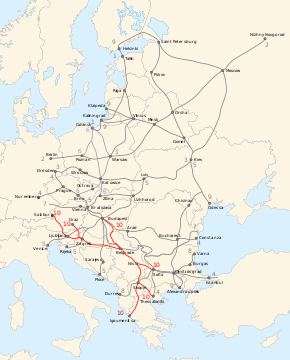Pan-European Corridor X
| Pan-European Corridor X | |
|---|---|
 Pan-European Corridor X highlighted in red | |
| Major junctions | |
| Start end | Salzburg (Austria) |
| End end | Thessaloniki (Greece) |
| Location | |
| Countries | Austria, Slovenia, Croatia, Serbia, Bulgaria, Republic of Macedonia, and Greece |
| Highway system | |
| Pan-European corridors | |
The Corridor X is one of the pan-European corridors. It runs between Salzburg in Austria and Thessaloniki in Greece. The corridor passes through Austria, Slovenia, Croatia, Serbia, Macedonia, and Greece. It has four branches: Xa, Xb, Xc, and Xd.
The European Bank for Reconstruction and Development has given loans to support infrastructure improvements along Corridor X.[1]
Branches
X: Salzburg - Ljubljana - Zagreb - Belgrade - Niš - Skopje - Veles - Thessaloniki.
- Branch A: Graz - Maribor - Zagreb
- Branch B: Budapest - Novi Sad - Belgrade
- Branch C: Niš - Sofia - Plovdiv - Edirne - Istanbul via Corridor IV
- Branch D: Veles - Prilep - Bitola - Florina - Igoumenitsa (Via Egnatia)
Branch A (Corridor Xa)
Corridor Xa runs between Graz, Austria and Zagreb, Croatia through Croatia, Slovenia, and Austria.
Branch C (Corridor Xc)
Corridor Xc follows the route Niš - Sofia - Plovdiv - Edirne - Istanbul.
The road in Serbia from Niš to the Bulgarian border nearby Dimitrovgrad currently is being upgraded to a motorway standard. The construction works in all sections are expected to be completed in 2018.
In Bulgaria, I-8 road connect Sofia with the Serbian border, but Kalotina motorway is planned to sepersede it. Currently the transit traffic has to pass via the Sofia Ring Road, but a new bypass Northern Speed Tangent is under construction since 2015[2] and is expected to be completed in 2016. Trakia motorway (A1) runs from Sofia to Chirpan, where Maritsa motorway (A4), completed in October 2015,[3] branches off to Turkey.
References
- ↑ "Railway Gazette: Corridor X funds awarded". Retrieved 2010-10-31.
- ↑ "The Construction of North Speed Tangent Starts up". RIA. 18 February 2015.
- ↑ "След 36 години АМ "Марица" най-после е готова!". plovdiv24.bg (in Bulgarian). Retrieved 29 October 2015.